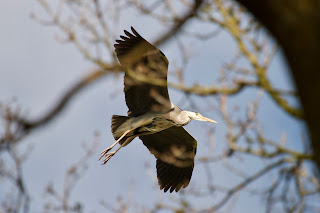Yesterday I had a break from revision and, after a morning of ringing, took part in the BTO's Heronries Census for the fifth consecutive year. I have been counting the apparently occupied nests at the same site in Cheshire since April 2014. There is actually a concentration of large heronries in Cheshire.
This year the Heronries Census celebrates it's 90th year. According to the BTO website, the census was only meant to be a one off survey back in 1928 for British Birds magazine, but it has carried on every year since and is probably one of the longest running data sets for any breeding bird in the world. The number of active heronries counted in the UK is now well over 500 each year and around
two-thirds of all heronries in England, Wales and the Isle of Man are currently counted each year.
The census counts herons, egrets and other colonial waterbirds, however this particular site is purely made up of Grey Herons. The site is a mix of deciduous and pine trees (Corsican and Scots) with the herons preferring to nest in the pines. On the walk to the heronry, one thing we all noticed was how behind everything seems to be. There were only a handful of Heron chicks calling, the hedgerows were still so bare and the deciduous tree buds were only just beginning to show signs of opening.
It's not until you actually get into the wood that realise just how active a heronry is. The adults are continuously flying in and out, and its quite eerie seeing so many of these pre-historic looking birds circling just above the trees.
Over the past 5 years, the heronry has had up to 71 apparently occupied nests, so just imagine for a minute the activity of over 100 adults nesting in close proximity!
The count really is a case of looking round the actual nests for signs that they are occupied. There are of course the obvious signs, the adult birds actually landing by their nests or hearing the chicks calling.
But there are plenty of other clues such as droppings beneath the nests, discarded and predated egg shells etc.
By the end of the afternoon the count of apparently occupied nests was 64. The last 5 years counts at this site show that the numbers appear to be quite stable:
2014 - 70
2015 - 64
2016 - 71
2017 - 69
2018 - 64
Following the count, we did the important engagement work and called in on the land owner to update him on the numbers and discuss the site generally.
If you are interested in getting involved, then visit the BTO's Heronries Census website page for more information.
Linking to Wild Bird Wednesday





Love the Heronries, we have quite a lot near me. But, 64 is a fine catch.
ReplyDeleteI'll never forget our first rookery experience either. It was so loud! And exciting. We saw nesting white egrets this winter, in Florida.
ReplyDeleteConsidering how many Little Egrets I see, I am amazed that there aren't more breeding in my area. Yes Findlay, I reckon wea are at least two weeks behind this year. Howvere, this is how it used to be with Spring starting late April/early May.
ReplyDeleteThat's great you were involved in that count. When we lived in Oregon we used to visit a Great Blue Heron rookery -- it was a wonderful thing to watch . but two years ago we learned from friends that the nest had blown down ... I hope the herons found another safe place to nest. I wonder if there is a similar count over here.
ReplyDeleteHerons are a favorite of mine. No matter how many pics I have, if I see one, I take another picture. My favorite is the in-flight shot.
ReplyDeletestrange! We have the herons where I live but I can´t remember ever seeing youg ones. They must be good at hiding.
ReplyDeleteWhat a great set of data this would be. Cant imagine there were too many egrets when it started!
ReplyDeleteCheers - Stewart M - Melbourne
Very good information is given in this blog...Everyone likes to have pets, if you want to keep it,
ReplyDeletethen we are the best pet's shop and best breeders in Dehradun,Uttarakhand(India).